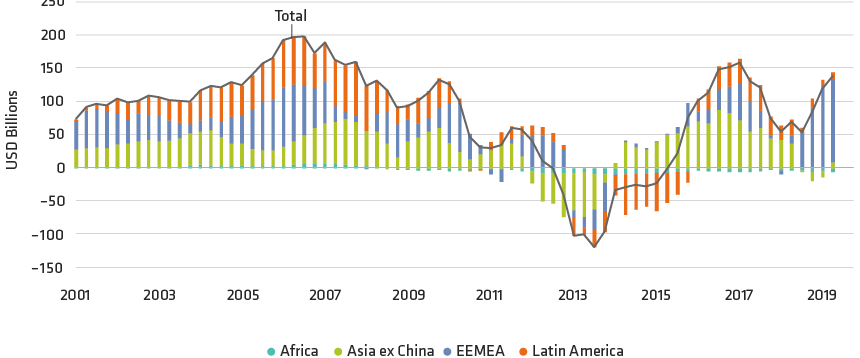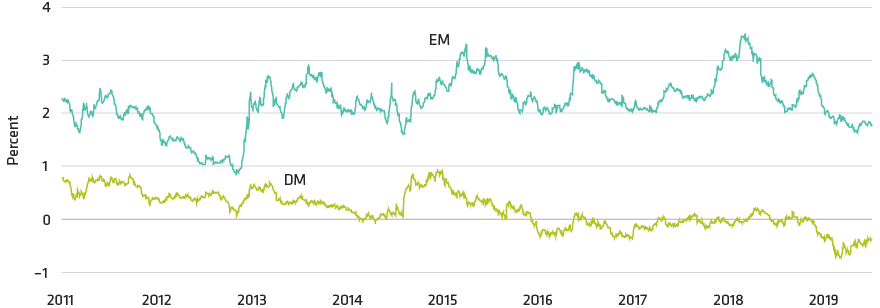In a banner year for capital markets, emerging-market debt (EMD) posted healthy double-digit returns. Global central bank easing, among other supportive factors, helped drive a broad-based rally across nearly all emerging-market (EM) countries. Can this strength continue through 2020?
We think it’s unlikely that returns will be as robust in 2020. EM and other bond investors will face a number of systemic risks in 2020—from a fraught geopolitical landscape to a global slowdown—underscoring the need to be more discerning. In the year ahead, the differences between EMD winners and losers will likely be marked.
On the other hand, we don’t see a dramatically darkening picture. Not only does the asset class offer attractive yield relative to developed-market (DM) debt of comparable quality, but we also expect most major influences on EMD performance to remain supportive.
Key Influences on Emerging-Market Debt
Let’s begin with a key risk that is mostly behind us. Last year was an important one for EM elections, which have the potential to disrupt policy and unsettle investors. Thankfully, most of 2019’s elections ran smoothly. In 2020, the main electoral risk comes from outside EM: specifically, the US presidential election.
In addition to a potential impact on global risk sentiment, the outcome of the US election in November could also affect other global factors, including US Federal Reserve policy. For now, the central bank has paused in lowering rates, but we believe the balance of risks is skewed toward further easing, which supports EM assets.
The US dollar traded in a very narrow range in 2019. We see few reasons for this to change in 2020. That said, any signs of a weakening US dollar would provide EM with a substantial boost, particularly on the currency side. December’s strong EM currency rally shows what can happen in a risk-on environment in which the US dollar weakens. We monitor such scenarios closely.
As for trade tensions, the US administration will likely continue to talk tough on trade but refrain from sparking more major conflicts ahead of the election. This stance gives room for Beijing to continue to manage China’s economic growth.
We expect Chinese real GDP growth to slip slightly to 6.0% in 2020 and to 5.8% in 2021. The People’s Bank of China will counter any downside pressure, including the potential impact of the Wuhan coronavirus, with further monetary and fiscal policy easing and with major infrastructure investment. These policies are a stabilizing force for EMD.
Given this backdrop, we advocate selective EMD investment in 2020.
Emerging Markets on the Rise
Improving measures of quality and current valuations support this view.
EM growth prospects look attractive today relative to those of DM, with some key EM countries now in the early stages of a cyclical recovery. We forecast EM GDP to grow at 4.4% in 2020—almost four times the rate of industrialized countries, at 1.2%. We expect easy monetary policy to continue across the developed world, while aggregate EM inflation levels stay low. This scenario would provide headroom for further rate cuts by some EM central banks. (We think it’s unlikely there will be a repeat of the broad-based EM easing of 2019.)
After the collapse in trade last year, the recent phase-one US–China trade deal alleviates concern about a near-term flare-up in the trade war, while also reducing uncertainty more broadly. Early signs of stabilization in global economic data are also promising for EM.
While the rise of populism increases investment risk globally, and like several other factors points toward selectivity in 2020, we’ve seen positive reforms in some EM countries. One of the most comprehensive reform packages was in Brazil, where the centerpiece reform to the country’s pension system was accepted without unrest.
EM external public-sector debt levels, though rising in absolute terms, have declined since 2012 when viewed as a percentage of GDP, net of currency reserves. Since 2015, they’ve been stable. In addition, as EM countries develop deeper and more liquid local debt markets, they increasingly fund their borrowing needs in local currencies. Local funding has increased resilience and lowered contagion risk, as it reduces EM borrowers’ exposure to currency crises.
In particular, EM economies are less vulnerable to external shocks than in the days of the taper tantrum, thanks largely to improving current account balances and stable foreign direct investment (FDI). Display 1 combines EM current account balances with FDI flows—typically a stickier, multiyear commitment—into EM countries. This “basic balance” measure provides a fuller (and today, a healthier) picture of EM countries’ external vulnerability. Notably, this is an aggregate measure, and pockets of weakness certainly remain—another reason why it will be important to be selective in 2020.





